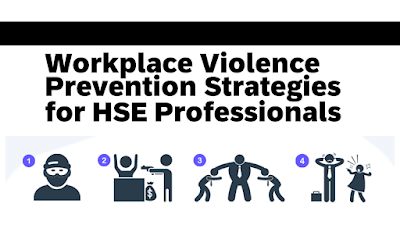Workplace Violence Prevention Strategies for HSE Professionals
The workplace violence
is a growing concern for any organizations and their employees. Workplace
violence is defined as any act of physical or verbal aggression, harassment, or
intimidation that occurs in the workplace. This can include threats, assaults,
and even homicide. Workplace violence can happen to anyone, but HSE
professionals are particularly at risk due to the nature of their work. HSE
professionals are responsible for ensuring the safety and health of employees
in the workplace, and they may be the first line of defense against workplace
violence. In this article, we will discuss workplace violence prevention
strategies for HSE professionals.
Conduct a Workplace Violence Risk Assessment
The first step in preventing workplace violence is to conduct a risk assessment. A risk assessment will help identify potential sources of workplace violence and assess the level of risk associated with each source. HSE professionals can use this information to develop prevention strategies that are tailored to their organization's specific needs. The risk assessment should include a review of past incidents, employee interviews, and a review of the physical environment.
Develop a Workplace Violence Prevention Plan
Once the risk
assessment is complete, HSE professionals should develop a workplace violence
prevention plan. The plan should include policies and procedures for preventing
and responding to workplace violence. This can include procedures for reporting
incidents, identifying warning signs, and training employees on how to respond
to an incident. The prevention plan should also include strategies for
addressing specific risks identified in the risk assessment.
Confined space standby man responsibilities
Train Employees
Training employees on workplace violence prevention is critical in preventing incidents. HSE professionals should provide employees with training on how to recognize warning signs of workplace violence and how to respond to an incident. Employees should also be trained on the organization's policies and procedures for reporting incidents and seeking assistance.
Develop a Threat Assessment Team
HSE professionals
should develop a threat assessment team to respond to incidents of workplace
violence. The team should be comprised of individuals from different areas of
the organization, including human resources, security, and management. The team
should have clear protocols for responding to incidents of workplace violence,
including procedures for notifying law enforcement and providing support to
affected employees.
Establish a Zero Tolerance Policy
Organizations should establish a zero-tolerance policy for workplace violence. This policy should clearly state that workplace violence will not be tolerated and that employees who engage in workplace violence will be subject to disciplinary action, up to and including termination. The policy should also outline the organization's commitment to preventing workplace violence and providing a safe work environment for all employees.
Foster a Supportive Workplace Culture
HSE professionals can
also promote a supportive workplace culture as a means of preventing workplace
violence. This can include creating a positive work environment, encouraging
open communication, and promoting employee wellness. A supportive workplace
culture can also help employees feel comfortable reporting incidents of
workplace violence and seeking assistance.
Steam Hazards and Safety Requirements
Continuously Monitor and Evaluate Prevention Strategies
HSE professionals should continuously monitor and evaluate their workplace violence prevention strategies. This can include reviewing incident reports, analyzing trends, and seeking feedback from employees. By regularly evaluating their prevention strategies, HSE professionals can make necessary adjustments and ensure their prevention plan remains effective.
Conclusion
Workplace violence is a
serious concern for HSE professionals. By conducting a workplace violence risk
assessment, developing a prevention plan, training employees, establishing a
threat assessment team, fostering a supportive workplace culture, and
continuously monitoring and evaluating prevention strategies, HSE professionals
can prevent workplace violence and ensure a safe work environment for all
employees.
Construction Safety Pictorial Guidelines

No comments:
Post a Comment